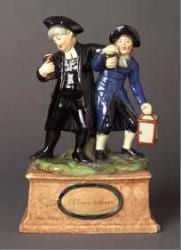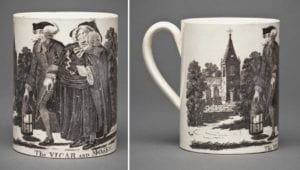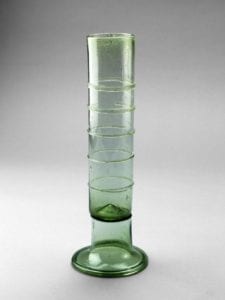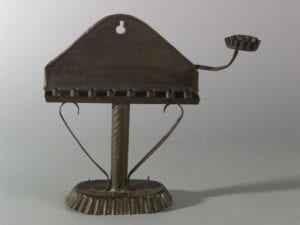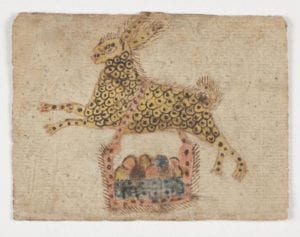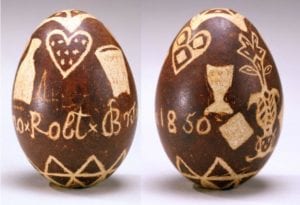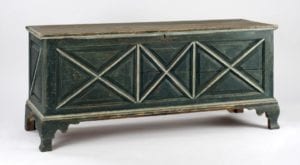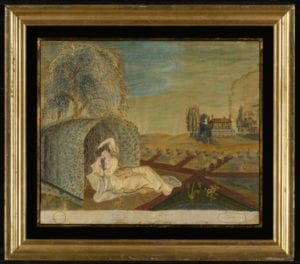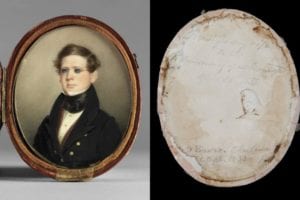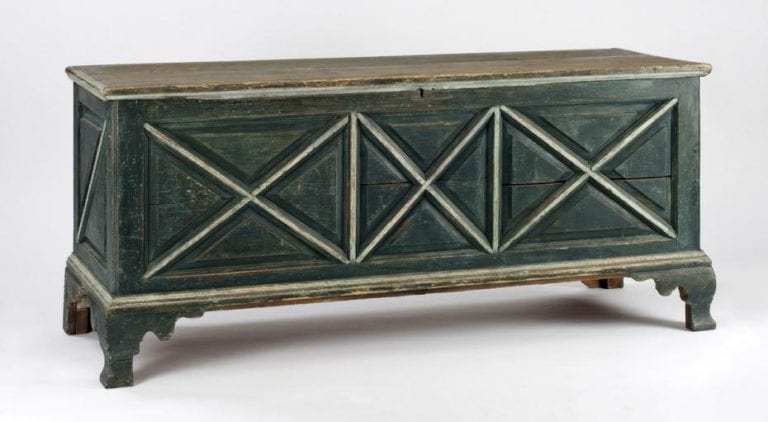
Winterthur continually acquires objects for its museum collection through gifts and purchases. The following is a small selection of recent acquisitions.
Ceramics
Vicar and Moses figure group
Staffordshire, England; 1810
Earthenware (pearlware)
Height: 11.25″ (28.575 cm)
Width: 7.5″: (19.05 cm)
Depth: 4.563″ (11.59 cm)
Gift of Thomas N. and A. Pat Bernard
2002.30.84
Vicar and Moses mug
Possibly John Aynsley
Lane End, Staffordshire, England; 1785-1805
Earthenware (creamware)
Height: 3.74″ (9.5 cm); length: 4.055″ (10.3 cm)
Diameter: 2.912″ (7.4 cm)
Gift of John A. and Judith C. Herdeg
2011.18
“The Vicar and Moses,” a satirical poem popular in the 1700s, was a commentary on the perception by many church-goers that the clergy paid more attention to worldly wealth and luxury than to their religious duties. From the mid-1700s onward, this subject was represented in published prints and songs and, later in the century, in ceramic form. The printed subject on the mug reappears with the rhyme on some other vessels and probably was inspired by a 1785 print published in London by Bowles and Carver. Like the freestanding figure group shown here, the printed views capture the portion of the story when the clerk, Moses, goes to a tavern, in theory to drag the vicar away from his drink, so that he may bury a young child. Moses joins the vicar in drinking, and eventually the two of them stumble back to the church, lighting their way with a lantern. These two objects are currently on view in the exhibition, Uncorked! Wine, Objects & Tradition.
Furniture
Chest
Eastern Shore of Virginia, 1770-1800
Pine, paint, iron
Height 53″ (134.620 cm); width 18″ (45.720 cm); depth 23″ (58.420 cm)
Museum purchase with funds provided by the Henry Francis du Pont Collectors Circle, 2011.16
The representation of southern furniture in Winterthur’s collection is limited, and long on the curators “want list” has been an example of raised panel furniture from the Eastern Shore of Virginia. Usually made of hard yellow pine and painted, these objects have rarely survived with their original paint due to the deleterious effects of the resinous portions of the pine that did not retain the paint. Most were stripped to a “knotty pine” appearance in the late 19th and early 20th centuries, so examples with original paint are not only unusual but highly desirable.
This three panel-chest with paneled ends is a rare survivor, retaining approximately 60–70% of a combination of the first and second generations of blue paint. In addition to the original paint, the chest has the added importance of a provenance that associates it with one of the early planter families on the Shore. Boldly written in graphite on the underside of the lid is the name “John Cobb,” presumably a descendant of English immigrant John Cobb who arrived in 1642 and received a patent for 600 acres along Occohannock Creek in 1661.
Glass
Passglas
Germany or Netherlands; 1600-25
Glass (nonlead)
Height: 11.7″ (29.8 cm); diameter: 4.1″ (10.5 cm)
Gift of Richard and Pam Mones, 2011.54
Passglas was a design popular in Germany but also the Netherlands, Denmark, Finland, Estonia, and Sweden during the 16th through 18th centuries. A passglas is a tall glass, sometimes cylindrical, but more often having six or eight sides and marked with glass rings or bands at regular intervals.
As the name of this drinking glass indicates, it was intended to be shared and was sometimes passed among several drinkers. The horizontal rings on such glasses are said to indicate the amount to be drunk by each person before the vessel was passed on. Such glasses were for wine, beer, ale and other alcoholic beverages and sometimes were used in drinking games. The challenge was–in one drink–to drink exactly from one horizontal stripe to the next; the penalty for inaccuracy was to drink to the next stripe.
This type of vessel was made in northern Europe from the 1500s through the 1700s and, as the form is derived from earlier Venetian types, is referred to as façon de venise (or “in the Venetion style”). Typically associated with Germany and the Netherlands, passglas production also may have taken place in Denmark, Finland, Estonia, and Sweden.
At the time this vessel was made, northern European glassware was arriving at colonial American settlements. Passglas fragments were excavated at the St. John’s site, about a quarter of a mile northeast of St. Mary’s City, Maryland. First occupied in 1635, St. John’s was the principal residence of Governor Charles Calvert from 1661 to 1666. Afterwards, it continued as a meeting place for the assembly and was leased to a series of innkeepers. At least 21 façon de venise vessels were found at the site.
Metalwork
Hanukkah lamp (Menorah)
Possibly Ipswich, Massachusetts, 1820-80
Tinned sheet iron
Height: 10.8″ (27.432 cm); width: 12.25″ (31.115 cm); depth: 4″ (10.160 cm)
Gift of Cipora O. Schwartz in memory of Philip C. Schwartz
2011.30.2
This Hanukkah lamp was designed to hold eight candles with an additional detached candle holder (the shamash) used to ignite them cumulatively during the Jewish Festival of Lights. Hanukkah lamps have ancient origins as oil-burning lamps, but by the 1700s, they were produced with candles and candle sockets as well as oil reservoirs. Historically, these lamps were made from a variety of inflammable materials, but base metals (pewter or brass) and silver examples survive with frequency from craftsmen working in Europe and North Africa. These lamps are used inside homes for religious observances only, commemorating the rededication of the Temple in Jerusalem (2nd century BCE), and not for domestic purposes.
Early American immigrants included people of the Jewish faith traveling from England, Europe, the Caribbean, and South America. This sheet iron Hanukkah lamp is an example with little intrinsic value made for a family of modest means; thus, today, it is quite rare. Historic Hanukkah lamps, especially with an American provenance, do not frequently appear in the collector’s market.
Paintings
Portrait miniature of Dr. Alexander Baron (1810-42) of Charleston, SC
by Charles Fraser, Charleston, SC, 1782-1860
Watercolor on ivory
Height: 4.5″
Museum purchase with funds provided by the Henry Francis du Pont Collectors Circle
2010.29 A-C
A miniature by Charleston artist Charles Fraser has long been on Winterthur’s “want list.” This portrait of Dr. Alexander Ladson Baron (1810¬–42) of Charleston, South Carolina, commemorates his first year of marriage to Sarah Gibbes DeSaussure (1811–91). Signed on paper backing of ivory by the artist–“C Fraser Charleston / SC Apl 1833″—the miniature is further inscribed on paper backing by the sitter: “Present for my wife / on the / 1st Anniversary of our marriage / April 26th 1833.”
Both Alexander Baron and his wife, Sarah, were members of prominent families of South Carolina and were instrumental in the governance, prosperity, and social affluence of Charleston. Baron’s father, the elder Dr. Alexander Baron (1745–1819), was a physician of renown and a founder of the Medical Society of South Carolina who “served for twenty-eight years as president of the St. Andrews Society, the oldest charitable society in the state.”
Charles Fraser was a popular and respected artist. The leading miniaturist in Charleston prior to the Civil War, Fraser studied and practiced law until 1817, when he took up painting. Although he lived in Charleston, he made many summer visits to northern states. He produced more than 500 miniatures in his lifetime, but he also painted still lifes and historic scenes. He worked in both oils and watercolors.
Fraser exhibited frequently at the Boston Athenaeum and showed work at the National Academy of Design (1826), the American Academy of the Fine Arts (1831, 1833, and 1834), the American Art Union (1849), the Artists Fund Society, the Pennsylvania Academy of the Fine Arts (1837), the American Art Union (1849), and in Charleston. He was made an honorary member of the American Academy of Fine Arts in 1825.
Textiles and Needlework
Embroidered and painted silk picture
Initialed EJ, Natchez, Mississippi, 1811
Silk, paint, wood
Height: 18″ (45.720 cm); width: 21.5″ (54.610 cm)
Museum purchase with funds provided by the Henry Francis du Pont Collectors Circle
2012.4.3 A, B
Until now, Winterthur’s collection has included only one example from the south, an embroidered and painted picture worked by Ann Custer of Charleston, South Carolina. This embroidered and painted picture from Natchez is a very sophisticated design, beautifully worked, and exceedingly rare. The five-chimneyed house occurs on schoolgirl art from many areas and must have been copied from a popular print.
Works on Paper
Drawing of Easter Bunny with basket of eggs
Attributed to Conrad Gilbert, Berks County, Pennsylvania, 1800
Museum purchase with funds provided by
Henry Francis du Pont Collectors Circle. 2011.10
Many of the most beloved American holiday traditions have their roots in southeastern Pennsylvania where German-speaking immigrants introduced customs such as the Easter Bunny and decorated Easter eggs, along with the Christmas tree.
This delightful image is attributed to schoolmaster Johann Conrad Gilbert (1734–1812), who emigrated from Germany in 1757 and ultimately settled in Berks County, Pennsylvania. He likely made the drawing as a gift for one of his students. This drawing is an example of a Pennsylvania German tradition of decorated manuscripts known as fraktur, which include birth and baptismal certificates, family records, writing samples, and bookplates. The Easter rabbit drawing is one of the rarest of all fraktur, with only two examples known, and is a major addition to Winterthur’s collection.
Related Gift
Easter egg
Southeastern Pennsylvania, 1850
Gift of Jane and Gerald Katcher. 2011.35
Photograph by Richard Goodbody, courtesy of David A. Schorsch and Eileen M. Smiles.
Few decorated Easter eggs from the 1700s or 1800s remain today due to their extreme fragility. Winterthur was fortunate enough to receive an outstanding example of one, donated by Jane and Gerald Katcher, to accompany the Easter Bunny fraktur. This rare surviving egg is decorated with hearts and flowers as well as a decanter, two wineglasses, and a tumbler. The egg—most likely from a goose—is also inscribed with an abbreviated name “Jno Robt Brs” and the date 1850. By the early 1800s, many Pennsylvania Germans included decorated eggs as part of their Easter celebrations.
Children were taught to prepare nests for the Easter Bunny, who would lay colorful eggs during the night provided the children were well behaved. The eggs were typically dyed by simmering them in water with onion skins, which imparted a reddish-brown color. Additional colors were achieved with madder root, walnut hulls, hickory bark, and other materials. Most of the eggs were eaten over the holiday, but some were embellished with scratched decoration that was done with a sharp pin or knife in which designs, names, and dates were scratched through the dyed outer coating to reveal the white eggshell underneath. The decorated eggs were then exchanged as gifts.
According to Lisa Minardi, assistant curator at Winterthur and an expert on Pennsylvania German arts and culture, “The Easter Bunny fraktur and egg are extremely rare and important additions to the Winterthur collection. The fraktur, as one of the two earliest known depictions of the Easter Bunny in America, represents the very roots of this beloved holiday tradition, while the survival of the egg in such good condition is simply extraordinary. We are very grateful to the Henry Francis du Pont Collectors Circle and the Katchers for their generosity in supporting these acquisitions.”
